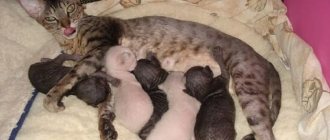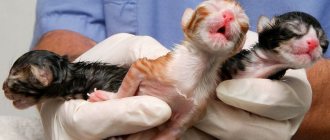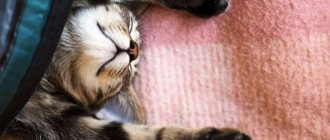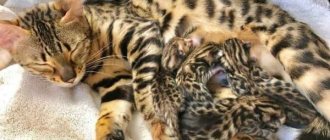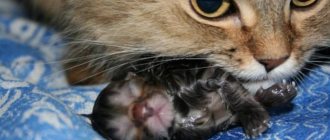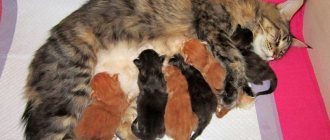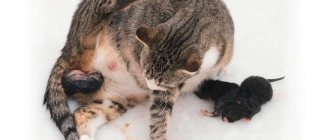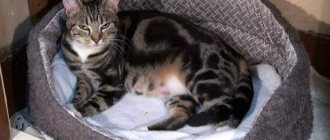The process of giving birth to a cat is a stage that can cause a lot of anxiety for cat caregivers. This is a process that occurs mainly inside the cat. Cats' inability to communicate verbally can make it difficult for us to understand how well a birth is going. This inadequate communication increases our anxiety as we want everything to go smoothly and for both mother and kittens to be healthy. To reduce anxiety and increase our willingness to help, we may have several questions that we need to answer.
In we discuss how long it usually takes a cat to give birth. In this way, we can help cat owners know whether the animals they care for are doing well and whether there is cause for concern. In the latter case, the help of a veterinarian is recommended.
Cat pregnancy
Normally, pregnancy in most breeds lasts 63 days, but deviations up or down by 3 days are possible, and this is not a pathology. A month after the start of conception, when stroking the belly, you can already feel the kittens. But it is impossible to determine the quantity in this way, since they are very small - barely reaching 3 cm in length.
Gradually, the cat's belly begins to grow. From the 5th week, it is not recommended to probe the abdominal wall of your pet for a long time and often, as this can harm the normal course of pregnancy.
If the owner is impatient to find out about the number of future offspring and its condition, an ultrasound can be performed at a veterinary clinic.
From the 6th week of pregnancy there is a significant increase in the size of the expectant mother’s belly, and after another 7 days, when you put your hand on it, you can feel the kittens actively moving in the womb.
In the last week, it is already difficult for the cat to move, she rests a lot and begins to look for a secluded place where she will give birth. Therefore, it is worth preparing in advance for this process, which can begin any day. You need to find and put a large box in a secluded place so that the pet can safely give birth to babies and live with them there for some time.
We recommend an article about the duration of a cat's pregnancy.
Postnatal care for the cat and offspring
For the first few days after lambing, it is necessary to maintain a relatively stable temperature in the “cat house” (about 28-29 degrees). You should ensure your cat has an easily digestible diet. This can be a “light” feed five times a day, as well as an abundance of dairy products to replenish the calcium lost by the animal. Among other things, you should take care of sufficient drinking regime.
It was previously mentioned that the length of time a cat bears kittens largely depends on the breed of the animal. Many people are interested in how long pregnant British cats walk, since the breed is quite common and owners are afraid of missing the most important moment of lambing. When asked how many days a cat carries British kittens, we can answer that the duration of pregnancy in British cats is about 63-70 days. It is noteworthy that specialists in some veterinary clinics do not know that the duration of pregnancy in cats depends on the breed and, if they suspect a delay in lambing, they resort to cesarean section. That is why owners should study all the intricacies of this process themselves in order to be informed.
Another interesting question: how long do pregnant Scottish cats walk? This breed usually survives for about 62-65 days. But the record holders are considered to be Siamese cats, whose lambing most often occurs on the 58-60th day.
A cat is ready for pregnancy already at 8-9 months of life, but experts do not recommend taking your pet for mating before a year.
Owners should prepare for lambing in advance: they should monitor how many days pregnant cats walk, pay attention to the behavior of the pet and provide the necessary assistance in a timely manner directly during childbirth. If you are not sure that the assistance will be provided with high quality, it is better to agree in advance with the veterinarian about the possibility of coming. Read more about care after lambing in the article “Cat with kittens: proper care after birth.”
Infertility and multiple pregnancy: what affects fertility
There are many theories why cats give birth to different numbers of kittens and what this depends on. Among the most widespread are:
- Influence of nutrition. If there is insufficient or poor quality food, the cat's chances of becoming pregnant are reduced. Nature seems to protect dead and weak kittens from being born. This is called nutritional infertility.
- Obesity. At the same time, many animals stop estrus, which indicates serious hormonal changes in the body. And in this condition, pregnancy cannot occur at all.
- Comfortable living conditions: cleanliness, comfort, favorable emotional climate, absence of stressful situations and other factors.
- Heredity. If the cat's mother gave birth to a small number of kittens, then you should not expect multiple pregnancies from your pet.
- Diseases of the reproductive system that affect the ability to conceive. For example, endometritis, pyometra and others.
- Temperament of a cat. Ovulation in cats occurs under the influence of the active behavior of the male during intercourse. Accordingly, the more active the partner is, the more eggs will be released and their fertilization will occur. If the cat is phlegmatic, there will be fewer kittens.
- Just like people, pets can be incompatible with each other. Therefore, if there is no pregnancy from a particular partner, you can try to change him.
- The quality of a cat's sperm also plays an important role. With prolonged abstinence or frequent sexual intercourse, it decreases sharply. It also depends on the living conditions of the animal, the psychological climate, healthy food, the general condition of the body, the absence of chronic diseases, etc.
- Hormonal imbalance in a cat, in which little follicle stimulating hormone (FSH) is released, which leads to the release of a small number of eggs. This, in turn, also applies to low-fertility pregnancies.
- Weight, age and general condition of the expectant mother’s body. Older cats give birth to fewer kittens.
- Pedigree and barn cats have different fertility rates. The latter most often give birth to many kittens, and this trend does not change with the age of the pet. Animals with blue blood have a tendency to have low-fertility pregnancies.
- Some breeders believe that the number of offspring is related to the number of matings. After the first time, one or two kittens are born, by 7 - the maximum possible for a given individual, and then their number decreases again.
- Another opinion is that the faster intercourse occurs from the beginning of estrus, the greater the number of new pets will be born.
All these theories have both confirmation and refutation. For example, if you adhere to the opinion that nutrition and stress affect pregnancy, it turns out that yard cats that do not have owners should not give birth at all, but they bring the maximum number of pets and calmly bear and raise them in the future. At the same time, females who are in calm home conditions with sufficient nutrition and care cannot always please their owners with kittens.
Also read about discharge from a pregnant cat.
Useful rules
There are several tips that, if followed, will not only help you carry and give birth to healthy babies for the first time, but will also keep you calm and on your nerves:
- A cat's pregnancy must be planned. And during the preparatory period, you need to consult a doctor, check for contraindications, possibly do a pelvic ultrasound and undergo some tests.
- A primiparous cat should maintain good physical activity , but without excessive stress. The objects she needs should be within reach so that the pet does not try to jump too high. There is no need to let a pregnant animal go outside unaccompanied.
- The future mother's nutrition should be complete and balanced . Deficiency of important elements should not be allowed: calcium, proteins, vitamins. Meat products and dairy products are required in the diet. Perhaps your doctor will recommend a vitamin complex. Do not neglect the recommendations if you want to get healthy offspring and keep your cat healthy.
- In the last days of pregnancy, purchase medications that may be needed during labor : Oxytocin to stimulate contractions, Gamavit to support the mother's body, Ringer's solution to prevent dehydration.
- If you are as inexperienced in feline birth as your pet, then you should think about professional help. If contractions occur, you can call the veterinarian at home, this will help prevent the occurrence of unforeseen complications.
- When assisting yourself during childbirth, carefully study the entire theoretical basis so that you are ready to provide assistance and do not panic at all. If health or life-threatening situations arise, seek medical help immediately.
Although labor is a natural process established by nature, the first time is always the most difficult, be it for a cat or for a person. After a couple of litters, your pet will become experienced enough to manage on her own. But it is better for a first-time mother not to be left without the support of a loving owner. And your task is to remain completely calm so that the inexperienced animal does not become even more nervous.
Fertility rate in cats
Felinologists have developed a large number of new breeds of cats, and often, for the sake of one trait, others were abandoned. Pedigree pets rarely give birth to more than 5 kittens, and yard representatives can give birth to 15 cubs. Accordingly, the more pets are born, the greater the likelihood that one of them will continue the family line.
For an approximate calculation of future offspring, professionals recommend paying attention to the number of nipples the expectant mother has. Subtract two from their number and get the approximate number of kittens that should appear. There can be from 6 to 11 mammary glands, but most often there are 8. This method is approximate and often does not work.
Features of pregnancy and childbirth in different breeds
Felinologists have noted a certain tendency during pregnancy in different breeds of cats:
- Representatives of cats with long hair reach maturity later than their short-haired counterparts, and their pregnancy lasts longer.
- Scottish Folds and British Folds give birth to fairly large kittens and often require veterinary care. And also the gestation period for their kittens is longer - up to 72 days, which leads to an increase in the size of the future offspring.
- With frequent pregnancies, the cat's body quickly depletes. This is a very important factor to consider when breeding animals.
- The duration of multiple pregnancies is most often reduced. Since this triggers natural protective mechanisms that prevent excessive exhaustion of the mother. The size of the kittens will also be slightly smaller compared to their counterparts born from a normal pregnancy. But this is compensated for, and they catch up with their peers in weight and development very quickly.
- Cats older than 7 years often give birth to pets with congenital anomalies or weakened ones. Therefore, upon reaching this age, it is recommended to stop mating. Such signs indicate the weakened health of the mother herself, which means there is no need to undermine it even more.
How many kittens can a cat give birth to?
Another logical question from owners: how many kittens can a cat give birth to at one time (the first time or the maximum number)?
As a rule, for the first time a cat can give birth to 1 – 3 kittens, since the cat’s reproductive system is not fully formed. Older cats also give birth to a small number of kittens - their reproductive function fades.
How many kittens can a cat in her prime give birth to at one time? Typically up to 6 kittens. After all, nature has endowed a cat with only 8 nipples, which means that it is difficult for a cat to feed more than 8 kittens.
However, there are exceptions. No one knows exactly how many kittens a cat can give birth to, but there have been recorded cases of the birth of 12 kittens.
Planning a cat's pregnancy
Pregnancy is a complex process and its planning, including in cats, is a very important stage. But the opinions of experts and ordinary owners on this issue differed:
- Often breeders or felinologists plan pregnancies in their cats no more than once a year. At the same time, they carefully monitor the pet’s health and take a responsible approach to choosing a cat. There is an opinion that with such frequency the female will feel great, which will affect the high quality of the offspring.
- Veterinarians have a different opinion. They believe that if each heat ends in the birth of kittens, this does not negatively affect the health of the cat or offspring. Therefore, pregnancy 3-4 times a year is the norm. Otherwise, if an animal is denied sexual activity, health and mental problems will arise.
- Owners with extensive experience think differently - two lambings every 12 months are enough to maintain the physical tone and well-being of the female, which also will not affect the health of the offspring. With more rare intercourse, the animal begins to suffer both morally and physically.
If not all babies are born, what should I do?
If your cat’s labor suddenly takes too long, you don’t need to immediately think about the bad. But it’s also not worth waiting until everything resolves itself. The first birth can be very long. If there are many kittens in the womb, the process may also take longer. But how can you tell if all the babies have come out? What if 1 or 2 are left inside, and the animal is not going to continue labor? So, when an owner should be wary:
- The cat has strange behavior.
- If you palpate the abdomen, you will notice a lump in it approximately the size of a kitten.
- The cat's tummy does not "deflate".
- The temperature increased to 39 degrees.
- Greenish discharge appeared from the vagina.
It also happens that a mother simply decides to “rest” a little, having already produced 4-5 babies. And during the break, the cat calmly goes about her maternal business: licking the kittens, feeding them, eliminating the remains of the placenta. If the cat looks calm and content, everything is fine; after some time, the remaining kittens will definitely be born.
But if one or more of the above symptoms are present, then having kittens in the womb can lead to big problems. The owner who notices something is wrong should urgently call a specialist. Every minute is worth it. Not only unborn kittens are at risk, but also the cat herself.
How to help a cat during its first birth
Usually a cat instinctively knows how and what to do during childbirth, but for the first time it may get scared and hide in an inaccessible place, for example, under the bed. Therefore, it is important for the owner to prepare in advance for such an important process.
How to prepare a place for childbirth
When giving preference to a place for childbirth, you need to adhere to some rules:
- Availability. Having made a box with bedding for a future woman in labor, it is important to make sure that she does not have to jump into it. You can cut out the door or remove part of the wall, then both the cat and the owner will have greater access inside.
- Capacity. It must be remembered that the pet, along with the born kittens, will be there not for one day, but for up to 2 months, so there should be enough space for both the mother and the growing offspring.
- Silence. Select a place in an apartment or house where it will be as quiet and peaceful as possible; this could be a secluded corner or the space between the sofa and the wall. Otherwise, the cat will start to worry and hide, for example, in a closet. This behavior indicates that she does not feel protected in the designated area and you need to think about moving her to a quieter place.
- Convenience. It is worth putting a layer of clean old cloth or gauze at the bottom of the box; you can buy special absorbent sheets at the pharmacy. This will create additional comfort for the woman in labor.
When is a cat ready to become a mother?
Puberty in felines occurs in 4-5 months, and can last up to almost a year - this is influenced by many factors. The female can become pregnant at the age of 5-9 months. If she is walking on her own or there are several animals in the house, it is better to think about this in advance. Mating is considered optimal at one and a half years, when the body is fully formed and ready for pregnancy and the birth of kittens.
A lot also depends on the time of year. As a rule, sexual heat in street animals (they go to the toilet outside, go for walks) begins in January and continues until November. The peak occurs in the warm season. Pets are ready to breed all year round.
Most often, cats become pregnant in the summer, but in general it can happen at any time of the year.
Harbingers of childbirth
A few days before the start of the long-awaited event, many owners note a change in their pet’s behavior:
- 2-3 days before birth, the external genitalia swell slightly and turn pink. The cat begins to carefully lick its belly and wash itself.
- Decreased activity - becomes detached, apathetic.
- Lack of appetite. Often within a day or so, most cats will refuse to eat. There is no need to insist, they themselves know how it will be better for them. But you need to take care of fresh drinking water.
- A few hours before the onset of labor, the female begins to experience training contractions of the uterus, and the animal begins to instinctively arch its back. Having noticed such manifestations, you need to limit the cat’s movement, transfer it to a prepared box and stay nearby while awaiting birth. Otherwise, being frightened, she may hide in a hard-to-reach place.
- The cat begins to follow the owner and meow pitifully. This behavior indicates the imminent onset of labor. With this cry she is trying to ask for help and support from people. You need to calm her down, pet her and be nearby in case she or the kittens need help.
- The amniotic fluid begins to recede, but the owner may not notice this, since the cat can lick it off.
What to do if the labor process is very weak?
If half an hour has passed after your water breaks and labor has not begun, this is a cause for alarm. The cat needs urgent help, but you can’t rush too much - careless and thoughtless actions can only cause more harm.
The owner can carry out a number of the following actions:
- lubricate your fingers with Vaseline (baby cream);
- very carefully insert your fingers into the pet’s vagina and try to pull the kitten by the shoulders with weak, screw-like movements (you can’t pull by the head, you can inadvertently break the baby’s neck and kill him);
- support the pet’s abdomen with your other hand;
- if the contractions have stopped, knead the pet’s back and tummy to stimulate a new effort.
These measures should be resorted to only in extreme cases! If 30 minutes have not yet passed after contractions, you cannot induce labor yourself.
Childbirth
The cat's belly begins to contract in waves. When it becomes palpable under the hand and visible to the eye, the birth process has begun. At the same time, she often breathes with her mouth open and meows pitifully. If within the first two hours from the start of contractions the first fetus does not appear, you need to urgently go to a veterinary clinic or call a doctor at home.
This is an alarming symptom and may indicate that the babies cannot come out or have gone sideways, which is a threatening condition not only for the offspring, but also for the mother in labor.
Most often, kittens are born in a birth bladder, which is torn and eaten by the mother and bites off the umbilical cord. Then she licks the kitten, thereby freeing its mouth and nose from mucus. The baby's squeak indicates that everything went well. They can appear either with their muzzles or with their paws forward. Then the placenta or placenta comes out.
It is important to ensure that their number corresponds to the number of kittens born.
If the afterbirth remains in the womb, this is fraught with inflammation of the uterus, which is dangerous to health. Cats eat the placenta, which contains the hormones needed to support labor and initiate lactation. If a lot of kittens are born, you should allow the female to eat 2-3 placentas and throw away the rest, as this can cause vomiting and diarrhea.
Almost immediately after birth, kittens begin to suckle milk. It is important to ensure that everyone is born; for this you should first perform an ultrasound and check the number of fetuses. If not all have been born, you need to seek veterinary help as soon as possible.
When is it necessary to call a veterinarian immediately?
You should contact your veterinarian if the process of giving birth to kittens differs in any way from the scenario we described above.
It is especially important to call a veterinarian in the following cases::
- Pregnancy lasts longer than 66 days.
- The mother's temperature has dropped to 37° Celsius and lasts for a day or more (the animal becomes very lethargic and apathetic).
- There is a partial or complete refusal of food, becomes depressed, weak, and does not respond to what is happening around.
- The cat's labor lasts more than a day, but without any particular results.
- Ten or more minutes have passed since the moment the amniotic sac burst, but contractions of the uterus and birth canal cannot push the emerging kitten out.
- Powerful contractions continue for more than an hour (the cat is literally “twisted”), but nothing happens.
- The cat's figure remains pear-shaped, but more than four hours have passed since the last kitten appeared. If your pet seems anxious and nervous, it is possible that there are still kittens in her uterus.
- If your vagina discharges a strange-looking or foul-smelling discharge.
- You counted fewer afterbirths than there were kittens. Please note that in cats, retained placenta is a severe pathology, very often leading to the death of the animal.
- The kittens seem pathologically weakened and cannot independently reach their mother’s nipples.
- The mammary glands of a cat that has not yet given birth are hard and painful to the touch. This sign may indicate acute mastitis. If kittens drink such milk, they will probably die.
- The kittens do not sleep, constantly crawl away from their mother and meow. This sign often indicates that the cat does not have milk (or there is too little milk for the entire litter). This often happens in the case of excessively numerous litters.
- Kittens have bloated and swollen tummies: most likely, something is wrong with their mother’s milk.
- The temperature of a cat who has given birth remains at 39.6° Celsius for 24 hours or more after birth.
The average duration of labor is about 12 hours . Deviations from this norm are quite acceptable, but still do not forget to take into account the condition of your cat.
Postpartum period
The absence of contractions for 2 hours and the prolapse of the abdomen indicates the completion of the birth process. The behavior of the female also changes: she calms down, her breathing evens out, she lies down more comfortably in the box, and continues to lick and feed the babies. You should not give food to a woman in labor immediately after birth, but you can offer water or milk. She usually drinks only when the process is over.
You need to carefully replace the diapers with clean ones and place a tray nearby so that the mother does not move away from the kittens for a long time. But it is not recommended to pick them up; the cat may lose interest in them or react aggressively to this. It's better to leave her alone for a while.
Stages of kitten birth
The birth process is usually divided into stages:
- The long stage is contractions.
- The middle stage is attempts and expulsion.
- The short stage is the expulsion of the placenta.
Labor begins with contractions. The uterus begins to contract, pushing the kittens into the cervix. Under pressure, the neck begins to expand. At this stage, a clear discharge appears from the cat's vagina. Less often and during rapid labor, a large volume of water comes out at once.
Important! The process of contractions, normally, can take from 10 to 12 hours. During prolonged labor, 24 hours may pass before pushing occurs.
